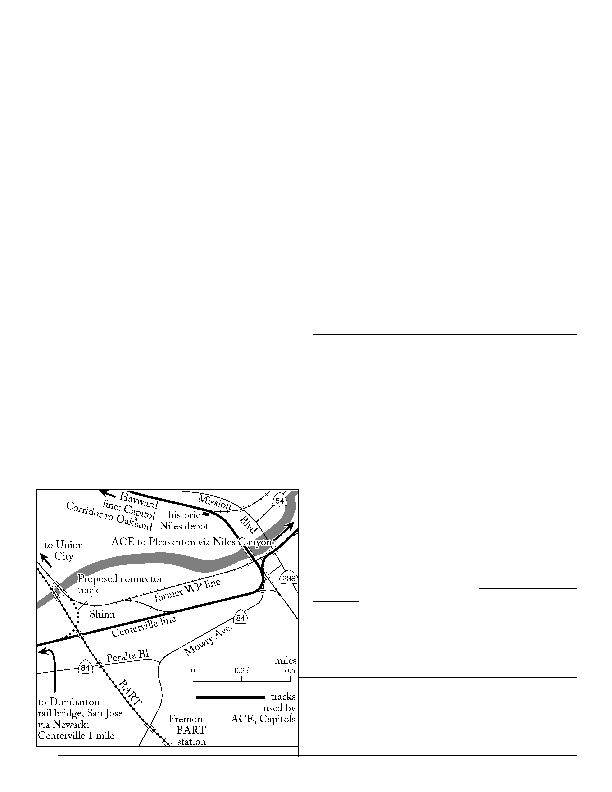6
Caltrain Schedule Changes
New Caltrain schedules are in effect starting February 6. Despite
official suggestions that these are the positive results of the new San Carlos
and Belmont grade-separated crossings, train speeds are slower than those
of 10 years ago, and they continue to fall.
A major impediment to faster schedules is the outdated design of
Caltrain’s double-deck gallery cars, unchanged in Caltrain’s new cars now
entering service. Loading for wheelchairs is marginally improved, and
the bright lighting may be appreciated by some. However, the new door
configurations slow passenger entry and exit, especially for cyclists. De-
spite millions of dollars in “improvements,” train schedules are length-
ened due to longer dwell times at stations.
This would not have occurred had Caltrain opted instead for the up-to-
date Bombardier double-deck cars used by ACE, Sounder (see other article
in this issue), and several other commuter rail systems. The Bombardier
cars have twice as many doors, and the height of their lower deck floors is
only inches higher than that of Caltrain’s station platforms.
[as this newsletter was going to press, Caltrain had just decided to pull
all the new cars out of service due to the extremely slow doors]
In his two letters to the JPB in Dec. ’97 and Jan. ’98, PR2000 board
member Richard Mlynarik detailed inadequacies of the new railcars ordered
for Caltrain. The JPB failed to solicit rider input, and held up the ordering
process for over two years. The letters are linked at
http://www.rail2000.org/
winter98/railcarlttr12-97.html
Dumbarton, continued
from
page
3
The current Dumbarton commuter rail plan sponsored by the San
Mateo County Transportation Authority (SMCTA) calls for six round trip
commuter trains between Union City, Fremont-Niles, Fremont-Centerville,
and Newark. The proposed trains would connect with BART at Union
City, and with ACE and the Capitol Corridor trains at the Fremont-
Centerville station. On the Peninsula, the commuter trains would make a
station stop in the Belle Haven/East Palo Alto area. At Redwood Junction
in Redwood City, one-half of the morning trains would operate north to
the Millbrae Caltrain station and one-half would operate south to San Jose.
Enroute, these trains would serve Silicon Valley, the Oracle Mile (Belmont/
San Carlos), and other important employment centers. In the afternoon,
six trains would operate in the reverse direction and return to Union City.
Project planners estimate that 2,500 passengers would use the trains
each day. The annual operating subsidy would be about $2.7 million. The
current plan is to use an extension of the Dumbarton highway bridge $1
seismic retrofit toll surcharge to fund the $63 million cost to reconstruct the
Dumbarton rail bridge. SMCTA would provide $42 million to purchase
rolling stock and SMCTA has pledged a total of $60 million for the project.
SamTrans owns the Dumbarton rail bridge which it purchased from South-
ern Pacific in 1994.
Downtown Niles Station Advocated
Under SMCTA’s proposal, the Dumbarton trains in the East Bay would
reach the Union City BART station via an expensive connector track at
Shinn, just east of Centerville, to link the former Western Pacific (WP)
Canyon Subdivision, which runs parallel to BART, to the former Southern
Pacific (SP) Centerville line used by ACE and the Capitols which runs
perpendicular to BART. Local Fremont residents and business groups
favor an alternative proposal. They would like the Dumbarton trains to
remain on the former SP line, make a new stop in downtown Niles, and
then continue north, as the Capitols do, on the Hayward line via Niles
Junction. The historic downtown Niles station is located near one of the
most congested automobile intersections in Fremont: Mission Boulevard
(Hwy 238) and Mowry Avenue (Hwy 84). A train station here would
reduce congestion in this corridor and support Niles redevelopment. The
Niles community in Fremont, through the Niles Redevelopment Plan,
wants to restore the 1904 SP Niles depot as the Niles district’s focal point.
Capital and operating costs of routing the trains via downtown Niles
are likely to be comparable to costs of routing the trains on the former WP
north of Shinn. Currently, no tracks properly connect the SP Centerville
line and the WP line at Shinn. The SMCTA Dumbarton proposal includes
plans to link the two by expensive track construction with a short tunnel
under a BART embankment. This track connection at Shinn is estimated to
cost $6.8 million. Routing the trains via downtown Niles would avoid this
expensive connection. The $6.8 million could be used to increase the ca-
pacity of Niles Junction where Capitol Corridor, ACE, Dumbarton, and
Union Pacific freight trains converge. Planners expect that Union Pacific
would require improvements at Niles Junction as a condition of operating
the Dumbarton trains.
For Fremont, there is a smarter way to plan transportation improve-
ments—one that brings near-term solutions to the area’s traffic congestion
problems without requiring commuters to wait more than a decade for a
BART extension to San Jose that would cost billions and serve only north-
south commuters. Many believe the Dumbarton commuter rail proposal
and expanded ACE services are the right solutions for our transportation
problems today, and would yield benefits in a relatively short timeframe.
Visit PR2000’s Dumbarton rail web page at http://www.rail2000.org/
dumbarton for more articles, maps, and full text of the 1999 SMCTA
Dumbarton Rail Corridor Study.
Part 2 of this article, to appear in a future edition of
Staying on Track, will track the latest developments in
obtaining the support of Fremont and Alameda County
for commuter rail, including Alameda County’s Mea-
sure B sales tax renewal.
Staying on Track, No. 2000-1, February 2000
Staying
on
Track
is
a
publication
of
Peninsula
Rail
2000,
a
501(c)4 non-profit group. We encourage your contributions. Ar-
ticles and letters should be submitted no later than the last day of the
month
for
consideration
for
the
next
newsletter.
E-mail
to
russellr@sfsu.edu, okuzumi@silcon.com, or fax to (408) 732-8712.
map courtesy of Russell Reagan

